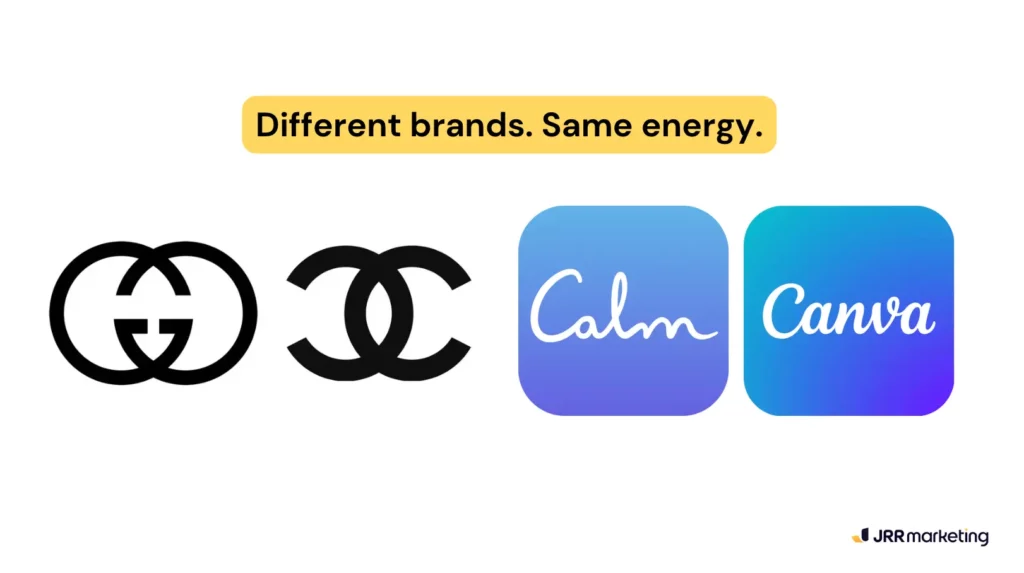Key takeaways
- Similarity bias is a mental shortcut that makes people trust others who look, act, or think like them.
- It makes a weird idea feel safe, as long as it’s wrapped in something people already get.
- In marketing you can use this bias to make your ads easier to click, your pages easier to skim, and your copy easier to trust.
We all like people who are like us.
That’s similarity bias.
It’s a mental shortcut that makes us trust, like, and agree with people, ideas, or brands that feel familiar.
It’s the brain’s way of trying to save energy.
If something looks like something you already trust — a face, a font, a phrase — you’re more likely to go along with it.
One study even found that people are more likely to trust someone whose face subtly looks like their own.
It’s that weird.
And that’s powerful.
In marketing, similarity bias gets blamed for a lot.
Safe creative.
Same copy.
Teams who all think alike and nod at the same stuff.

View on Threads
But like other powerful psychological biases, it’s only dangerous if you don’t know what you’re doing.
It builds trust faster.
It gets clicks.
It makes the unfamiliar feel safe enough to try.
The trick’s using familiarity on purpose.
And here are five ways to do that without blending in, selling out, or sounding like every brand in your inbox.
5 ways to use similarity bias
#1 — Use patterns people already trust
People don’t have time to figure out what your ad or site is trying to say.
If it looks familiar, they’ll know what to do.
That’s why predictable layouts work.
They lower the effort it takes to click, scroll, or buy.
A Forrester study found that a well-designed UI can improve conversion rates by up to 200%.
And a familiar UX can push it even higher.
When a landing page follows the basic flow people expect, it’s easier to know where to click and why they should care.
It’s not about copying.
You’re just reducing friction.
Apple nails this.
Every product page has the same scroll pattern.
Big image, short line, feature highlight, repeat.
You don’t have to learn a new layout every time.
Notion does the same with their templates.
The structure stays the same, but the content changes.
This way, people can focus on the value, not figuring out how the page works.
And this matters for more than just websites.
Familiar subject lines get more email opens.
Familiar CTA formats get more clicks.
So, go ahead and use patterns people already trust.
Just make sure the content still feels like you.
Sameness is only a problem when it hides the message.
When it makes things easier, it works.
#2 — Use their words, not your buzzwords
People trust people who sound like them.
The same goes for brands.
If you write your ad copy and make it sound like something they’d say out loud (or type into Google), it hits differently.
That’s similarity bias doing its thing again.
Slack nailed this one.
They don’t sound like enterprise software.
They sound like someone on your team.
Casual, quick, a bit nerdy… just like their audience.
This made people feel like Slack “got” them.
That’s trust, baked into the tone.
You don’t need to be a genius to do this.
Just pay attention.
Look at support tickets.
Sales calls.
Product reviews.
Anywhere your audience actually talks.
Pull out the phrases they repeat.
Look at the way they describe their problem.
Take note of the words they use instead of your jargon.
Then use that language naturally in your copy.
When it sounds like you wrote it for them, they’re more likely to believe it.
#3 — Wrap new things in familiar language
New ideas are risky.
People don’t always get them.
And when they do, they don’t always trust them.
But if something feels kind of familiar, it feels safer.
Easier to explain.
Easier to buy.
That’s why early startups always pitched themselves as “Uber for X” or “Airbnb for Y.”
It made something unknown feel instantly gettable.
Look at how Canva grew.
They didn’t launch as “a graphic design platform.”
Instead, they said things like “drag-and-drop design for non-designers.”
It sounded like tools people already knew, like PowerPoint, or maybe even Instagram Stories.
So it clicked.
To do this well, start with what your audience already understands.
Use references, comparisons, or phrases they already use.
Anchor your big idea to something they’ve seen before.
It speeds up the “ohhh, I get it” moment.
That’s how you sell something new without making it feel like a leap.
#4 — Surprise them on purpose
People don’t mind being surprised.
They just don’t want to feel lost.
That’s the trick with similarity bias.
If something feels predictable, people pay attention without feeling confused.
And once they’re in that comfort zone, that’s when you can break the pattern.
Dollar Shave Club’s first ad looked like a standard explainer video.
Clean office.
Founder talking to camera.
Then came the weird jokes, swearing, and a machete.
It worked because the format felt safe.
The surprise felt intentional, not random.
Duolingo’s TikTok content does the same.
At first glance, it looks like every other brand mascot doing a dance.
But then it gets unhinged.
Messy.
Unapologetically weird.
Image from Indy100
The structure sets the tone. The twist makes it memorable.
To use this, start with something your audience expects… a familiar headline, layout, or tone.
Then subvert one thing.
Just enough to stand out.
That balance is what sticks.
#5 — Use social proof that feels close to home
Asking for testimonials is one thing.
Getting useful ones is another.
A generic five-star review from “Samantha, CEO” won’t move anyone.
But a messy, honest quote from someone who sounds like your actual buyer definitely would.
The closer the person feels to your audience, the more they’ll listen.
So if you’re targeting scrappy founders, show quotes from scrappy founders.
If you’re selling to B2B marketers, don’t feature feedback from a DTC founder (even if it’s glowing).
This works with UGC, too.
Match the tone your marketing persona uses.
Mirror their humour, their doubts, their language.
Again, people trust people who feel like them.
So don’t just show happy customers.
Show familiar ones.
Use the bias but don’t be a basic b*tch
Similarity bias is a shortcut, but don’t make it your sole strategy.
It helps people trust you faster, sure.
But if you stop there, you’ll end up sounding like everyone else.
Familiarity gets attention.
But difference is what keeps it.
The smart way to do it is to use the bias on purpose.
Borrow the format.
Mirror the tone.
Drop the reference.
Then flip it just enough to stand out.
Because basic is easy to ignore.
And ignored marketing doesn’t convert.


